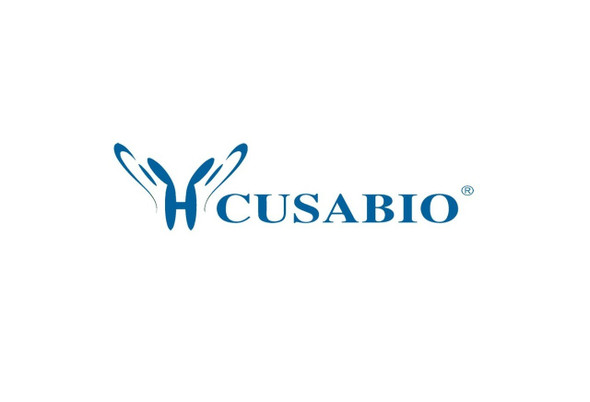Cusabio Human Recombinants
Recombinant Human Clusterin (CLU) , partial | CSB-EP005595HU1
- SKU:
- CSB-EP005595HU1
- Availability:
- 3 - 7 Working Days
Description
Recombinant Human Clusterin (CLU) , partial | CSB-EP005595HU1 | Cusabio
Alternative Name(s): Aging-associated gene 4 protein;Apolipoprotein J ;Apo-JComplement cytolysis inhibitor ;CLIComplement-associated protein SP-40,40Ku70-binding protein 1NA1/NA2Testosterone-repressed prostate message 2 ;TRPM-2
Gene Names: CLU
Research Areas: Apoptosis
Organism: Homo sapiens (Human)
AA Sequence: DQTVSDNELQEMSNQGSKYVNKEIQNAVNGVKQIKTLIEKTNEERKTLLSNLEEAKKKKEDALNETRESETKLKELPGVCNETMMALWEECKPCLKQTCMKFYARVCRSGSGLVGRQLEEFLNQSSPFYFWMNGDRIDSLLENDRQQTHMLDVMQDHFSRASSIIDELFQDRFFTREPQDTYHYLPFSLPHRRPHFFFPKSR
Source: E.coli
Tag Info: N-terminal 6xHis-tagged
Expression Region: 23-224aa
Sequence Info: Partial
MW: 27.8 kDa
Purity: Greater than 90% as determined by SDS-PAGE.
Relevance: Isoform 1 functions as Extracellular domain chaperone that prevents aggregation of nonnative proteins. Prevents stress-induced aggregation of blood plasma proteins. Inhibits formation of amyloid fibrils by APP, APOC2, B2M, CALCA, CSN3, SNCA and aggregation-prone LYZ variants (in vitro). Does not require ATP. Maintains partially unfolded proteins in a state appropriate for subsequent refolding by other chaperones, such as HSPA8/HSC70. Does not refold proteins by itself. Binding to cell surface receptors triggers internalization of the chaperone-client complex and subsequent lysosomal or proteasomal degradation. Secreted isoform 1 protects cells against apoptosis and against cytolysis by complent. Intracellular isoforms interact with ubiquitin and SCF (SKP1-CUL1-F-box protein) E3 ubiquitin-protein ligase complexes and promote the ubiquitination and subsequent proteasomal degradation of target proteins. Promotes proteasomal degradation of COMMD1 and IKBKB. Modulates NF-kappa-B transcriptional activity. Nuclear isoforms promote apoptosis. Mitochondrial isoforms suppress BAX-dependent release of cytochrome c into the cytoplasm and inhibit apoptosis. Plays a role in the regulation of cell proliferation
Reference: NIEHS SNPs programDNA sequence and analysis of human chromosome 8.Nusbaum C., Mikkelsen T.S., Zody M.C., Asakawa S., Taudien S., Garber M., Kodira C.D., Schueler M.G., Shimizu A., Whittaker C.A., Chang J.L., Cuomo C.A., Dewar K., FitzGerald M.G., Yang X., Allen N.R., Anderson S., Asakawa T. , Blechschmidt K., Bloom T., Borowsky M.L., Butler J., Cook A., Corum B., DeArellano K., DeCaprio D., Dooley K.T., Dorris L. III, Engels R., Gloeckner G., Hafez N., Hagopian D.S., Hall J.L., Ishikawa S.K., Jaffe D.B., Kamat A., Kudoh J., Lehmann R., Lokitsang T., Macdonald P., Major J.E., Matthews C.D., Mauceli E., Menzel U., Mihalev A.H., Minoshima S., Murayama Y., Naylor J.W., Nicol R., Nguyen C., O'Leary S.B., O'Neill K., Parker S.C.J., Polley A., Raymond C.K., Reichwald K., Rodriguez J., Sasaki T., Schilhabel M., Siddiqui R., Smith C.L., Sneddon T.P., Talamas J.A., Tenzin P., Topham K., Venkataraman V., Wen G., Yamazaki S., Young S.K., Zeng Q., Zimmer A.R., Rosenthal A., Birren B.W., Platzer M., Shimizu N., Lander E.S.Nature 439:331-335(2006)
Storage: The shelf life is related to many factors, storage state, buffer ingredients, storage temperature and the stability of the protein itself. Generally, the shelf life of liquid form is 6 months at -20?/-80?. The shelf life of lyophilized form is 12 months at -20?/-80?.
Notes: Repeated freezing and thawing is not recommended. Store working aliquots at 4? for up to one week.
Function: Isoform 1 functions as extracellular chaperone that prevents aggregation of nonnative proteins. Prevents stress-induced aggregation of blood plasma proteins. Inhibits formation of amyloid fibrils by APP, APOC2, B2M, CALCA, CSN3, SNCA and aggregation-prone LYZ variants (in vitro). Does not require ATP. Maintains partially unfolded proteins in a state appropriate for subsequent refolding by other chaperones, such as HSPA8/HSC70. Does not refold proteins by itself. Binding to cell surface receptors triggers internalization of the chaperone-client complex and subsequent lysosomal or proteasomal degradation. Secreted isoform 1 protects cells against apoptosis and against cytolysis by complement. Intracellular isoforms interact with ubiquitin and SCF (SKP1-CUL1-F-box protein) E3 ubiquitin-protein ligase complexes and promote the ubiquitination and subsequent proteasomal degradation of target proteins. Promotes proteasomal degradation of COMMD1 and IKBKB. Modulates NF-kappa-B transcriptional activity. Nuclear isoforms promote apoptosis. Mitochondrial isoforms suppress BAX-dependent release of cytochrome c into the cytoplasm and inhibit apoptosis. Plays a role in the regulation of cell proliferation.
Involvement in disease:
Subcellular Location: Isoform 1: Secreted, Note=Can retrotranslocate from the secretory compartments to the cytosol upon cellular stress, SUBCELLULAR LOCATION: Nucleus, Cytoplasm, Mitochondrion membrane, Peripheral membrane protein, Cytoplasmic side, Cytoplasm, cytosol, Microsome, Endoplasmic reticulum, Cytoplasmic vesicle, secretory vesicle, chromaffin granule
Protein Families: Clusterin family
Tissue Specificity: Detected in blood plasma, cerebrospinal fluid, milk, seminal plasma and colon mucosa. Detected in the germinal center of colon lymphoid nodules and in colon parasympathetic ganglia of the Auerbach plexus (at protein level). Ubiquitous. Detected in brain, testis, ovary, liver and pancreas, and at lower levels in kidney, heart, spleen and lung.
Paythway: Complementandcoagulationcascades
Form: Liquid or Lyophilized powder
Buffer: If the delivery form is liquid, the default storage buffer is Tris/PBS-based buffer, 5%-50% glycerol. If the delivery form is lyophilized powder, the buffer before lyophilization is Tris/PBS-based buffer, 6% Trehalose, pH 8.0.
Reconstitution: We recommend that this vial be briefly centrifuged prior to opening to bring the contents to the bottom. Please reconstitute protein in deionized sterile water to a concentration of 0.1-1.0 mg/mL.We recommend to add 5-50% of glycerol (final concentration) and aliquot for long-term storage at -20?/-80?. Our default final concentration of glycerol is 50%. Customers could use it as reference.
Uniprot ID: P10909
HGNC Database Link: HGNC
UniGene Database Link: UniGene
KEGG Database Link: KEGG
STRING Database Link: STRING
OMIM Database Link: OMIM









